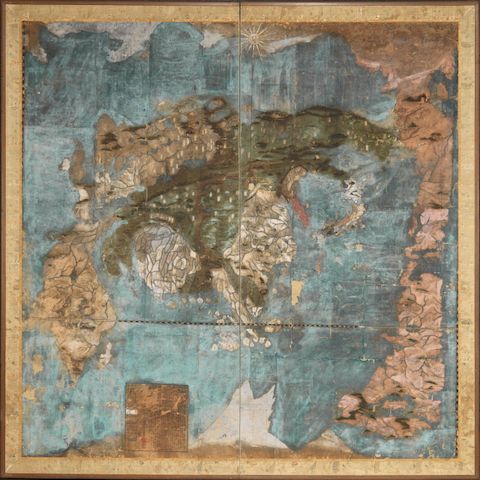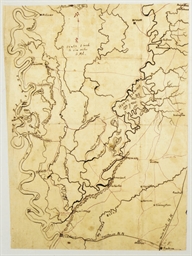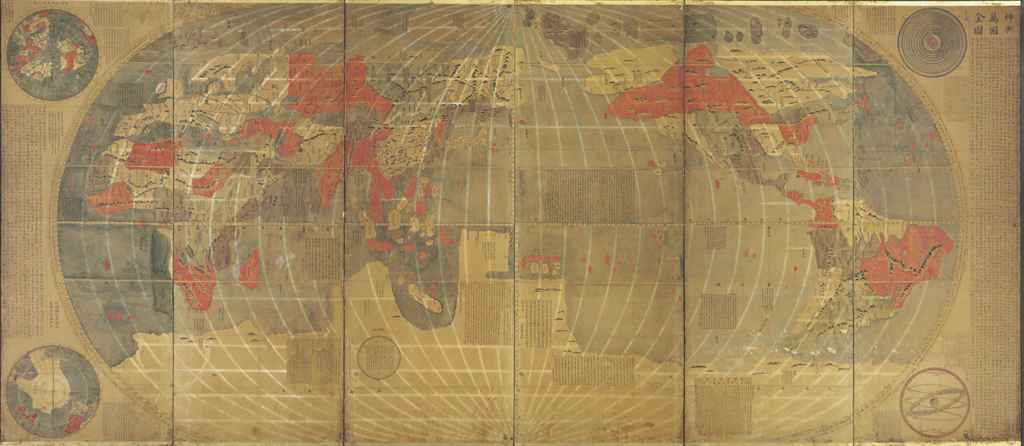HAYASHI, Shihei, after (1738-1793). Sanguo Tonglan Quantu. (Map with an Overall View of Three Kingdoms). Edo: Suharaya Ichibei, 1785. Very rare contemporary manuscript map of Shuhei's famous Sangoku Tsuran Zusetsu (Illustrated General Survey of the Three Kingdoms), which describes Joseon Korea, the Ryukyu Kingdom, and Hokkaido—considered the most important geopolitical treatise of the period. It was one of the first Japanese works to relate Japan to its neighbors and as such was banned by the Edo government in 1792. It is considered one of the first modern attempts to define Japan compared to foreign nations, raising the question of external borders and the claim of some islands. Hayashi Shihei (August 6, 1738 - July 28, 1793) was a Japanese military scholar, political theorist, and retainer of the Sendai Domain. His name is sometimes misread (according to the Sino-Japanese reading) as Rin Shihei. Shihei was deeply concerned with the rise of western military and naval power. In particular he saw Russia's expansion into East Asia as a long term threat to Japanese sovereignty. He lobbied the Tokugawa Shogunate for a strengthening of Japan's defenses and advocated supplementing traditional Samurai training with courses in Western military science. In particular he expressed concerns with the traditional role of the samurai as an independent warrior and stressed teamwork exercises, or choren. He published several important books, including the 1791 Kaikoku Heidan (i.e. Discussion concerning military matters of a maritime nation and the 1786 Sangoku Tsuran Zusetsu (Illustrated Description of Three Countries). This later work included five important maps illustrating Japan, Korea, and the Ryukyu Islands, including Taiwan. Since his work was published without authorization from the bakufu (government), and criticized the Shogun's commerce with foreign powers, Hayashi fell out of favor. Most of his works were subsequently seized and, along with their original woodblock printing plates, destroyed. Consequently, most surviving examples of the five Shihei Maps are manuscript, copied by hand and handed down in secret from generation to generation. Eventually a copy of Sangoku Tsuran Zusetsu was taken to Siberia, translated into French, and published in Paris in 1832. Hayashi's legacy was thus preserved and, together with Takayama Hikokuro and Gamo Sanbei, he is remembered as one of the "Three Excelling Men of the Kansei Period" (Kansei no san-kijin). The 1792 ban resulted in destruction of copies and printing blocks, however some manuscript copies survive, of which this is one. Only one or two of the five original engraved maps are recorded in public libraries (including three in the BNF), and there is no recorded surviving complete printed copy. A copy of Sangoku Tsuran Zusetsu was brought to Europe by Isaac Titsingh (1745-1812). In Paris, the text represented the first appearance of Korean han'gul in Europe. After Titsingh's death, the printed original and Titsingh's translation were purchased by Jean-Pierre Abel-Rémusat (1788-1832) at the Collège de France. Following Rémusat's death, Julius Klaproth (1783-1835) at the Institut Royal in Paris published his version of Titsingh's work. In 1832, the Oriental Translation Fund of Great Britain and Ireland supported the posthumous abridged publication of Titsingh's French translation. The present example is the pre-Klaproth Japanese manuscript issue, complete with five manuscripts maps in color, representing Ezo (Hokkaido), the Three Kingdoms, the Ryukyu Islands, the Kuril and Korea; and the illustrations of the text volumes are hand-colored (not always the case). Manuscript map, ink and color on 6 joined sheets of rice paper, 510 x 700 mm, folded into paper covers to 265 x 105 mm. Artist’s signature at the lower left corner with the date and place of execution, annotations in Chinese and Japanese written towards different orientations, Japan colored in yellow, orange and red, China in pink,
HAYASHI, Shihei, after (1738-1793). Sanguo Tonglan Quantu. (Map with an Overall View of Three Kingdoms). Edo: Suharaya Ichibei, 1785. Very rare contemporary manuscript map of Shuhei's famous Sangoku Tsuran Zusetsu (Illustrated General Survey of the Three Kingdoms), which describes Joseon Korea, the Ryukyu Kingdom, and Hokkaido—considered the most important geopolitical treatise of the period. It was one of the first Japanese works to relate Japan to its neighbors and as such was banned by the Edo government in 1792. It is considered one of the first modern attempts to define Japan compared to foreign nations, raising the question of external borders and the claim of some islands. Hayashi Shihei (August 6, 1738 - July 28, 1793) was a Japanese military scholar, political theorist, and retainer of the Sendai Domain. His name is sometimes misread (according to the Sino-Japanese reading) as Rin Shihei. Shihei was deeply concerned with the rise of western military and naval power. In particular he saw Russia's expansion into East Asia as a long term threat to Japanese sovereignty. He lobbied the Tokugawa Shogunate for a strengthening of Japan's defenses and advocated supplementing traditional Samurai training with courses in Western military science. In particular he expressed concerns with the traditional role of the samurai as an independent warrior and stressed teamwork exercises, or choren. He published several important books, including the 1791 Kaikoku Heidan (i.e. Discussion concerning military matters of a maritime nation and the 1786 Sangoku Tsuran Zusetsu (Illustrated Description of Three Countries). This later work included five important maps illustrating Japan, Korea, and the Ryukyu Islands, including Taiwan. Since his work was published without authorization from the bakufu (government), and criticized the Shogun's commerce with foreign powers, Hayashi fell out of favor. Most of his works were subsequently seized and, along with their original woodblock printing plates, destroyed. Consequently, most surviving examples of the five Shihei Maps are manuscript, copied by hand and handed down in secret from generation to generation. Eventually a copy of Sangoku Tsuran Zusetsu was taken to Siberia, translated into French, and published in Paris in 1832. Hayashi's legacy was thus preserved and, together with Takayama Hikokuro and Gamo Sanbei, he is remembered as one of the "Three Excelling Men of the Kansei Period" (Kansei no san-kijin). The 1792 ban resulted in destruction of copies and printing blocks, however some manuscript copies survive, of which this is one. Only one or two of the five original engraved maps are recorded in public libraries (including three in the BNF), and there is no recorded surviving complete printed copy. A copy of Sangoku Tsuran Zusetsu was brought to Europe by Isaac Titsingh (1745-1812). In Paris, the text represented the first appearance of Korean han'gul in Europe. After Titsingh's death, the printed original and Titsingh's translation were purchased by Jean-Pierre Abel-Rémusat (1788-1832) at the Collège de France. Following Rémusat's death, Julius Klaproth (1783-1835) at the Institut Royal in Paris published his version of Titsingh's work. In 1832, the Oriental Translation Fund of Great Britain and Ireland supported the posthumous abridged publication of Titsingh's French translation. The present example is the pre-Klaproth Japanese manuscript issue, complete with five manuscripts maps in color, representing Ezo (Hokkaido), the Three Kingdoms, the Ryukyu Islands, the Kuril and Korea; and the illustrations of the text volumes are hand-colored (not always the case). Manuscript map, ink and color on 6 joined sheets of rice paper, 510 x 700 mm, folded into paper covers to 265 x 105 mm. Artist’s signature at the lower left corner with the date and place of execution, annotations in Chinese and Japanese written towards different orientations, Japan colored in yellow, orange and red, China in pink,















Testen Sie LotSearch und seine Premium-Features 7 Tage - ohne Kosten!
Lassen Sie sich automatisch über neue Objekte in kommenden Auktionen benachrichtigen.
Suchauftrag anlegen